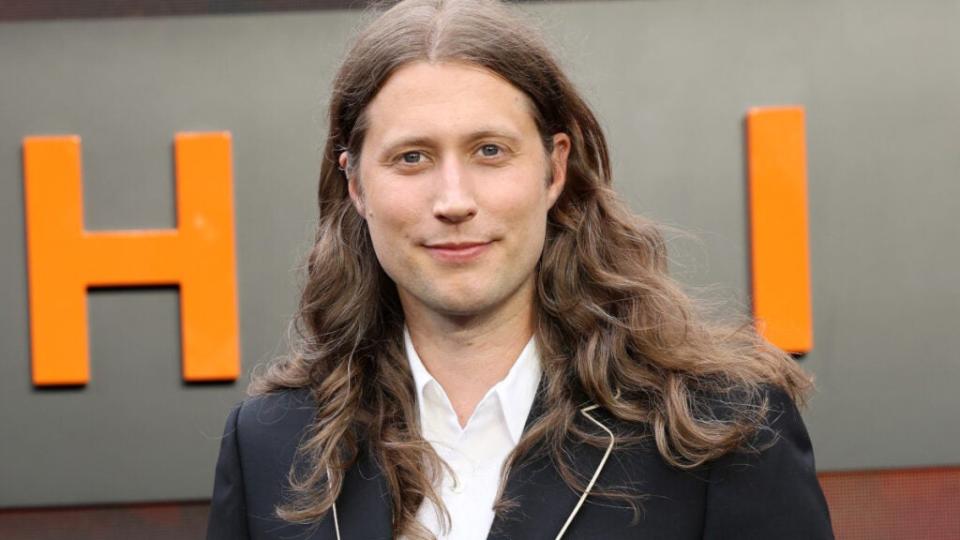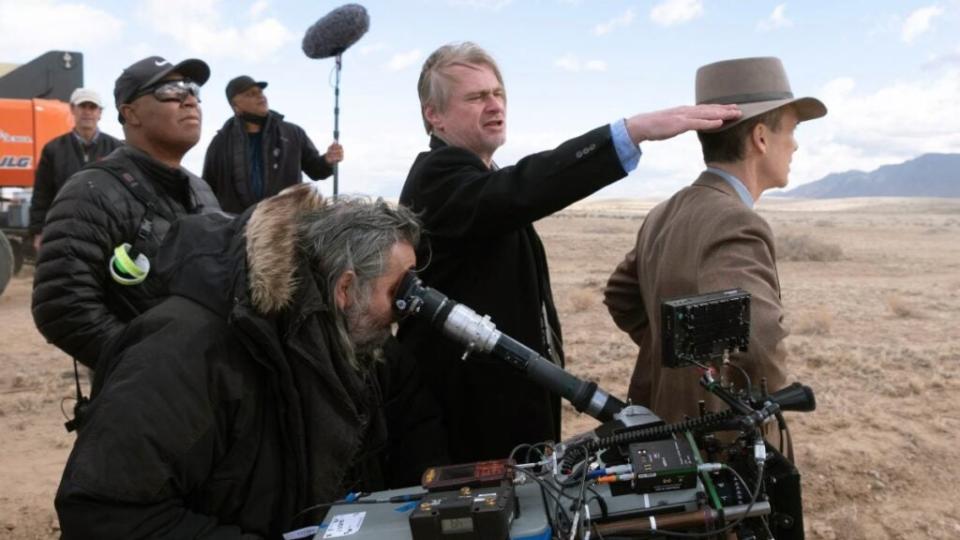How ‘Oppenheimer’ Composer Ludwig Goransson Channeled Impending Doom
- Oops!Something went wrong.Please try again later.
There’s a moment in Christopher Nolan’s “Oppenheimer” (in theaters now), where Niels Bohr, the famous Danish physicist (played by Kenneth Branagh) who developed the model of the atom, asks a young J. Robert Oppenheimer (Cillian Murphy), years before he would gain notoriety and infamy as the father of the atomic bomb: “Can you hear the music?” At that specific moment, the score by composer Ludwig Göransson quite literally soars – it’s beautiful and lilting but soon turns more menacing, even ominous. In that single musical moment (clocking in at less than two minutes on the official album), the entire movie – how the scientific idealism that gives way to untold horror – elegantly unfurls. And Göransson cements himself as one of Nolan’s most essential collaborators.
TheWrap spoke to Göransson about what it was like collaborating with Nolan a second time, why it’s OK to use electronics in the score for a period film and why he tackles so few projects at a time.
Göransson started out in the late 2000s producing albums for Childish Gambino (aka Donald Glover) while also scoring Glover’s NBC sitcom “Community.” At around the same time, he was providing additional music for composer Theodore Shapiro, working on movies like “Year One” and “Jennifer’s Body.” In 2013, he scored “Fruitvale Station” for his friend and former roommate Ryan Coogler; it would prove to be his breakthrough and in the years after he would score movies by Eli Roth (“Death Wish”) and Chris Rock (“Top Five”).
After working with Coogler on “Creed” and “Black Panther” (a score that earned him an Oscar nomination), in 2019 he crossed another milestone when he agreed to compose the music for Jon Favreau’s live-action “Star Wars” series “The Mandalorian” and created what can objectively be described as the most iconic piece of non-John Williams “Star Wars” music ever.
Around the same time that “The Mandalorian” started to stream on Disney+, Göransson was first contacted by Nolan. At the time, Nolan’s usual composer Hans Zimmer was busy with “Dune” (or at least that’s how the official story goes). Nolan was looking for somebody new for his latest project, a time travel spy thriller elliptically dubbed “Tenet.”
“We just spent six hours just talking about music and film,” Göransson remembered. With “Tenet” it was all about “earning that trust as collaborators and then keeping the relationship after.” The score is an absolute barnstormer, full of nervous, jittery electronics and big themes, which, thanks to Nolan’s famously aggressive sound mix, was put front and center – the scene with Robert Pattinson touring the “freeport” is awash in music, in a way few films are bold enough to attempt. Even if you never saw “Tenet” in a theater, the music left a huge impression. (It also seems to have inspired pop star The Weeknd; just listen to “Gasoline” from “Dawn FM.”)
Afterward, Göransson and Nolan would talk about films and music but Nolan would never let slip what he was working on next. Until, of course, he was ready.
“You get the phone call out of the blue: ‘Do you want to come in tomorrow and read the script for my new project?’ I don’t know what to expect,” Göransson said. Reading the script, for him, was “a jaw-dropping moment.” “Especially with how it’s different from anything else I’ve read with how everything is written from the perspective of Oppenheimer. You’re with him the whole time. You’re feeling what he’s feeling,” Göransson said. Nolan wrote the script in the first person. Instead of “Oppenheimer walks across the room,” the script would read: “I walked across the room.”

After reading the script, Göransson knew what he had to do. “There’s a full spectrum of feelings and emotions in there that needs to get portrayed by the music,” Göransson said.
Nolan then gave Göransson a directive: experiment with the sound of violins. “He was especially interested in experimenting with having that portray Oppenheimer, the sound of the solo violin, and how you can go between this beautiful romantic, heartbreaking tone if you have a lot of vibrato and soft notes and how you can immediately change the intensity of the vibrato and the pressure of your tone to make it into something neurotic and manic and horrific,” Göransson said. “Chris also knows my wife, Serena, is an accomplished violinist. Right after he gave that note, we went into the studio and just started recording her and came up with these experiments that were channeling what Chris was saying.”
Göransson was also intrigued by utilizing the violins in a way that they weren’t typically used. “Through time, strings and violin has been something that you experiment with. It set a tone for horror movies, for example, when you have the string cluster. That’s something that the audience is very used to,” Göransson said. “But what will happen if you take a string cluster like that, but you play it with a really romantic beautiful tone? How’s that going to feel like? That was something that we were looking for in Oppenheimer and his personality and how to channel that with those types of strings.”
Not that Göransson totally gave up the electronic flourishes that made his scores for “Tenet” and “The Mandalorian” (and more recently “Black Panther: Wakanda Forever”) so powerful and unique. “Chris didn’t give me any indication other than it just has to be a pure piece of music,” Göransson said, pointing to the costume department (where Nolan was inspired by David Bowie when picking Oppenheimer’s wardrobe) and the visual effects department, which utilized minimal computer-generated imagery to give the effects a more timeless feel. “I think that’s also what I wanted to do with the music. A lot of the instrumentation is from the time with strings and piano and harp, but infusing that with these synthesizers and modern production, which is channeling the impending doom, I thought it was a very interesting take on that,” Göransson said.
There was also a natural progression to Göransson’s use of electronics – while there are “hints” of it in the beginning, the synths don’t really make their presence known until the second act, “when there’s an actual bomb there.” “Before that, it’s just theories, it’s just scribble-downs, it’s just ideas,” Göransson said. “But then when there’s an actual physical bomb, you take a crazy big tonal shift and just channel that with those synths, with the impending doom. You have that thumping bass and then there’s this metallic ticking sound, and that ode is up until the bomb goes off, and then you have these moments of silence, which I think is very effective.”
And that silent patch, immediately following the Trinity test at Los Alamos, is one of the few moments without music in all of “Oppenheimer,” which Nolan once again puts front and center, oftentimes flooding the image with score, intensifying the movie’s overwhelming sense of dread. “I think that’s one of the things that make Chris such an interesting storyteller. He has a very great sense of ear, but it’s also how he lets the music play out in this story and the weight and the emphasis that he puts on the music,” Göransson said. There are two-and-a-half hours of music in the three-hour “Oppenheimer.” “That’s a big feat to do in a movie,” Göransson said.
When it comes to the “can you hear the music” moment, which Göransson described as “one of the biggest challenges of the movie.” Shortly after Göransson read the screenplay, he was invited by Nolan to attend a screening of visual effects test footage that was being worked on by production visual effects supervisor Andrew Jackson.

“I go into that room and I sit there in the dark theater and I just get hit in the face by this fluorescent light just spinning at me like, these atoms just swirling,” Göransson recalled. “And I was like, Damn, that’s so cool. I want the music to sound like that, but how do I make it?” Göransson wanted to capture the feeling of that test footage (later incorporated into the movie, including the “can you hear the music section” as a glimpse into the unseen subatomic world that haunted Oppenheimer) – which required rapid tempo changes. And he wanted to record it with live instrumentation.
He thought he would have to record things “two bars at a time,” later assembling them in the computer. A physics equation to be cracked. “But we figured out a new way to record, by giving the musicians something in their headphones, the new click [would tell them when to go] before it actually happens. And we made it possible to record that whole piece of music in one take. When I heard that first take, it just breathed so much more life into that piece of music,” Göransson said. “That was a big challenge.”
What makes Göransson’s music for “Oppenheimer” even more special is that it’s the composer’s only film score for all of 2023. Göransson has ceded the music for this year’s “Mandalorian” season, as well as the third installment in the “Creed” franchise, to Joseph Shirley, with whom Göransson worked on 2021’s prank movie “Bad Trip.”
“When I work on something, I like to fully dive into that with everything that I have – all my time, all my effort,” Göransson said. “Because I work on movies that I really care about and that are really special to me and that I feel like I learned something from. When I go into all of it and give all myself into it, that’s when I feel like I get something back too. And every time I approach a new project, I want it to feel like I’m doing something for the first time. I want to have a completely new approach on how I’m tackling a project.” Göransson also notes that most of the projects he’s worked on for the past few years have been time-consuming projects – not just “Tenet” and “Oppenheimer” but projects like “Wakanda Forever” and Pixar’s “Turning Red” (which was Göransson’s first animated feature).
As for his next project, Göransson doesn’t know. And maybe he doesn’t want to know.
“Every project I’ve been touching on the last five, 10 years, everything is just so different. I don’t have anything down the pipeline now, but some people are asking me, ‘What do you want to do next?’ And I’m not spending any time and energy on trying to make up something that doesn’t exist yet. So far, I’ve been very happy with the trajectory and the differences in every project. Right now I’m just going to spend some time with family over the summer and then we’ll see what happens afterward.”
That means, of course, that Nolan has not invited him to secretly read a script or watch some embryonic test footage. And while he’s been hugely fulfilled by their relationship so far, Göransson isn’t taking anything for granted. “The people that I do have relationships with, I feel like none of them wants to repeat themselves. Everyone wants to challenge themselves and make something that they haven’t done before. That’s also why I’m feeling like whatever I do, it’s going to be something different,” Göransson said.
When we brought up the persistent rumors of Nolan wanting to tackle James Bond (and whether he’d started thinking about what his 007 theme would be), Göransson said that he wasn’t aware of the rumors. “Maybe I need to spend some more time in those forums,” he joked.
Whatever Göransson ends up doing next, you can bet that he can hear the music. And we will too.
“Oppenheimer” is now playing exclusively in theaters.
The post How ‘Oppenheimer’ Composer Ludwig Goransson Channeled Impending Doom appeared first on TheWrap.

